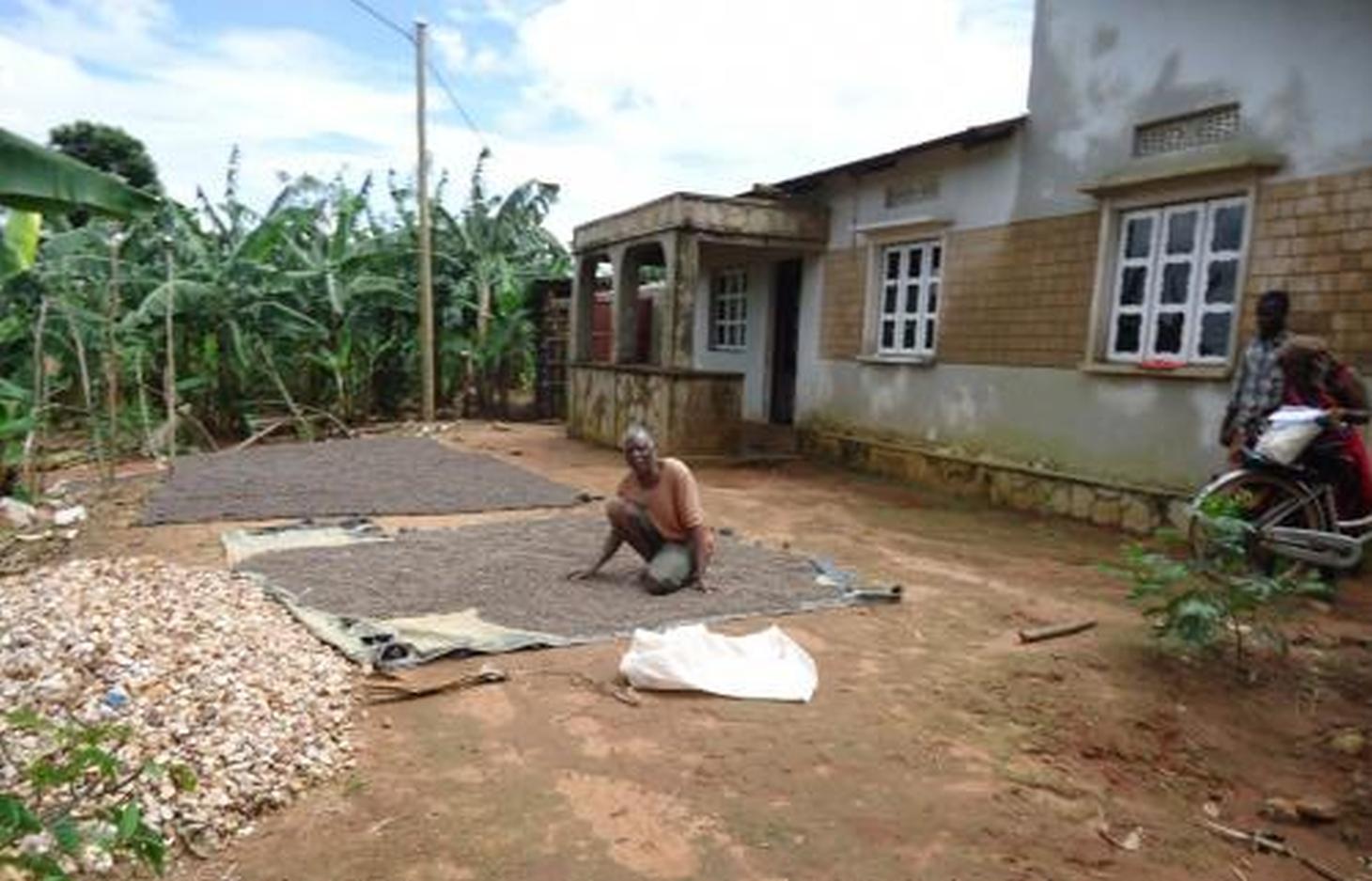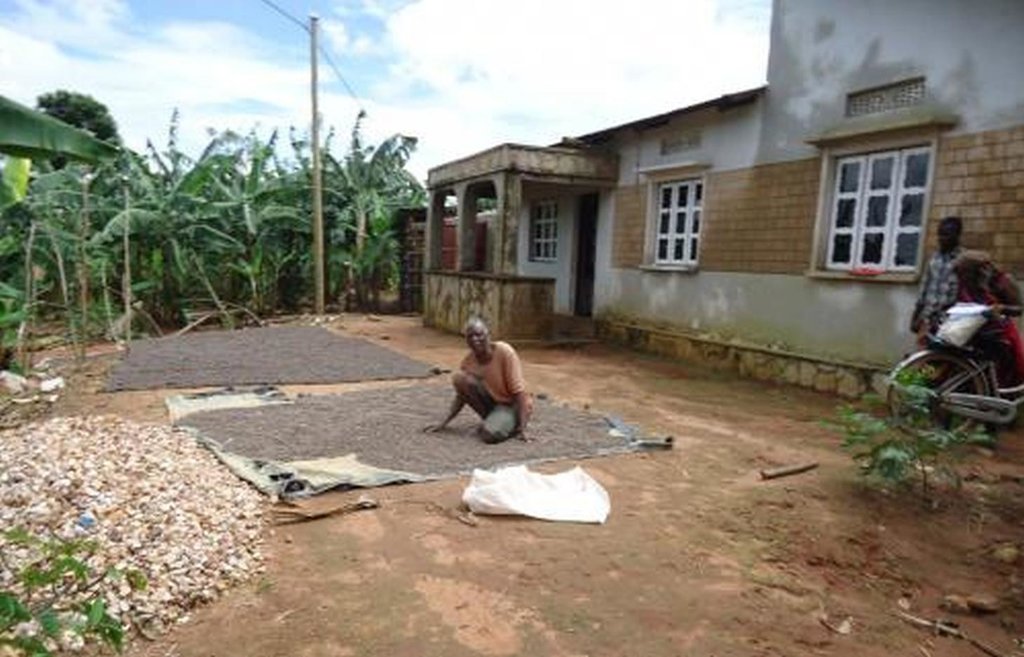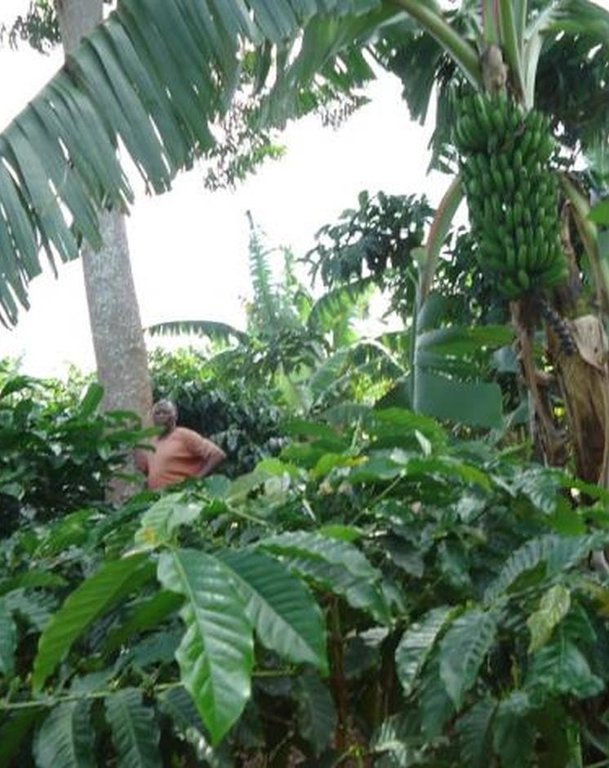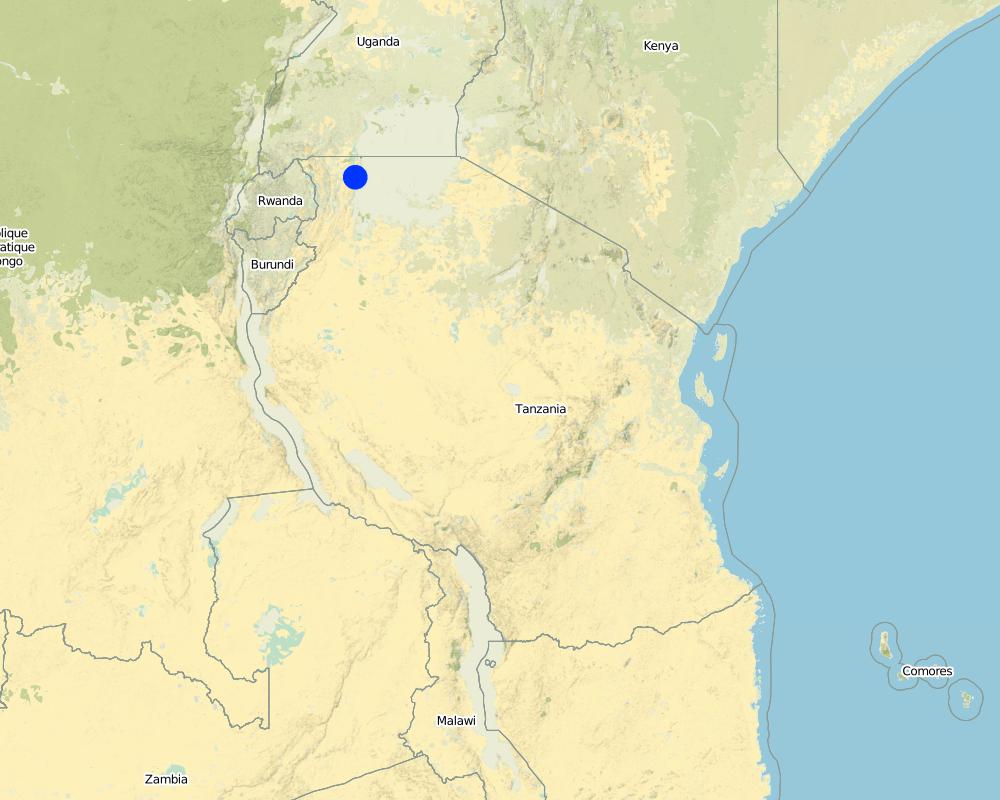Buhaya agroforestry system [แทนซาเนีย]
- ผู้สร้างสรรค์:
- การอัพเดท:
- ผู้รวบรวม: Godfrey Baraba
- ผู้เรียบเรียง: –
- ผู้ตรวจสอบ: David Streiff, Alexandra Gavilano
Ekibanja (Kihaya)
technologies_1177 - แทนซาเนีย
ดูส่วนย่อย
ขยายทั้งหมด ย่อทั้งหมด1. ข้อมูลทั่วไป
1.2 รายละเอียดที่ติดต่อได้ของผู้รวบรวมและองค์กรที่เกี่ยวข้องในการประเมินและการจัดเตรียมทำเอกสารของเทคโนโลยี
ผู้เชี่ยวชาญ SLM:
Government :
Government :
Mashauri Babylus
Bukoba DC
แทนซาเนีย
Government :
Rutatatinisibwa Dominick
Bukoba DC
แทนซาเนีย
Government :
Rwezaula Raphael
Bukoba DC
แทนซาเนีย
ผู้เชี่ยวชาญ SLM:
Kaihura Fidelis
K-TAMP
แทนซาเนีย
ผู้ใช้ที่ดิน:
Shaaban Habibu
Kyema village farmer
แทนซาเนีย
ชื่อของโครงการซึ่งอำนวยความสะดวกในการทำเอกสารหรือการประเมินเทคโนโลยี (ถ้าเกี่ยวข้อง)
The Transboundary Agro-ecosystem Management Project for the Kagera River Basin (GEF-FAO / Kagera TAMP )ชื่อขององค์กรซึ่งอำนวยความสะดวกในการทำเอกสารหรือการประเมินเทคโนโลยี (ถ้าเกี่ยวข้อง)
Food and Agriculture Organization of the United Nations (FAO) - อิตาลีชื่อขององค์กรซึ่งอำนวยความสะดวกในการทำเอกสารหรือการประเมินเทคโนโลยี (ถ้าเกี่ยวข้อง)
Bukoba district council (Bukoba district council) - แทนซาเนีย1.3 เงื่อนไขการใช้ข้อมูลที่ได้บันทึกผ่านทาง WOCAT
ผู้รวบรวมและวิทยากรหลักยอมรับเงื่อนไขเกี่ยวกับการใช้ข้อมูลที่ถูกบันทึกผ่านทาง WOCAT:
ใช่
1.5 Reference to Questionnaire(s) on SLM Approaches (documented using WOCAT)
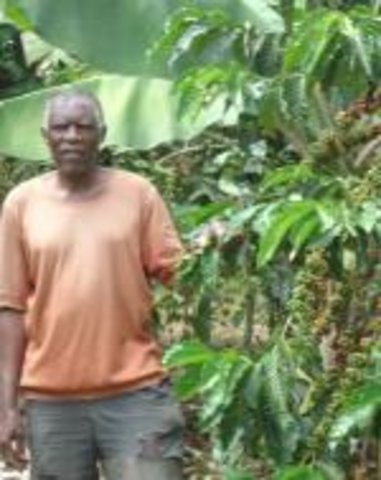
Indigenous knowledge transfer [แทนซาเนีย]
Indigenous knowledge transfer, is a common phenomena in farming societies whereby elders taught younger generations the practical aspects in production and emphasizes the norms and proms in folk story tales.
- ผู้รวบรวม: Godfrey Baraba
2. การอธิบายลักษณะของเทคโนโลยี SLM
2.1 การอธิบายแบบสั้น ๆ ของเทคโนโลยี
คำจำกัดความของเทคโนโลยี:
Traditional agroforestry system comprising mixture of banana, coffee, fruit trees, biannual crops, annual crops and timber trees which together optimize the use of soil, moisture and space.
2.2 การอธิบายแบบละเอียดของเทคโนโลยี
คำอธิบาย:
Buhaya agro forest system is a mix of annual and perennial crops together with trees and shrubs are densely planted on a restricted area usually 0.5 -2ha per household to increase crop yield, wood production and conserve soil and water. Buhaya agro forest system is applied on individual owned land specific at home steady. In this technology a plot of 1ha comprises of :
1.Perennial crops (coffee, banana, ) on average (10,000/36 coffee plants can be planted in one hector randomly in the alternating manner with banana, 10,000/25 banana stools) can be planted in 1ha randomly in the alternating manner with coffee.
2.Annual and biannual crops (eg. Maize, beans, cassava, sweet potatoes, yams etc) are planted in the between spaces. Maize and beans are planted twice in the short (Masika) and long rains (Vuli) where tubers are planted at any time throughout the year.
3.Trees and shrubs (eg. Makkhamia spps, Maesopsis and migorora). Trees are planted along the boundaries spaced at an average of 15m to act as wind break and timber production. Shrubs are planted at closed distance in between trees to act as live fence.
Buhaya agro forest system was practiced since early 1900. Application of farmyard manures and crop residue mulch are the supportive measures. The land owners keep small livestock/ few cattle under zero grazing to obtain manure for soil fertility improvem
Purpose of the Technology: The purposes for applying the technology is to control soil erosion and nutrient improvement.
Establishment / maintenance activities and inputs: The establishment of Buhaya agro forest system is done on a virgin land starting in the dry season July to September and it normally takes 2-5years by doing the following activities.
1.To prepare the land by cutting, removing/burning shrubs and grasses followed by land tillage. This is the difficult job and sometimes it can force the farmer to plant annual crops before planting perennial crops due to inadequate preparation time.
2.To dig holes of different size according to what crop is meant for in the alternating manner. This activity is done after harvesting annual crops in shot rainfalls (March to June).
3.To plant banana in July and August followed by coffee in September to November and March to May next year.
4.To plant trees along the boundaries followed by planting shrubs between the trees spacing to create a live fence.
5.To plant cassava, yams, pawpaw, avocados and mangoes. These are planted randomly and in a few quantity.
The maintenance of Buhaya agro forest system is the simple but tidies job requires all the year to be working in the garden. The required activities are
1.To weed the field as preparation for planting seasonal crops( i.e maize and beans) twice per year in dry seasons.
2.To remove unwanted banana suckers (desuckering) and harvested banana stems in order to maintain a required number of plants( mother, daughter and grand daughter) per stool. This requires a lot of time for assessing the plant health as well as spacing.
3.To plant and harvest maize and beans twice per year.
4.To prune coffee trees, harvest coffee cherry, dry, and market them once per year.
5.To replace harvested cassava and yams as required.
2.3 รูปภาพของเทคโนโลยี
2.5 ประเทศภูมิภาค หรือสถานที่ตั้งที่เทคโนโลยีได้นำไปใช้และได้รับการครอบคลุมโดยการประเมินนี้
ประเทศ:
แทนซาเนีย
ภูมิภาค/รัฐ/จังหวัด:
Tanzania
ข้อมูลจำเพาะเพิ่มเติมของสถานที่ตั้ง :
Bukoba District (Kyema village)
ระบุการกระจายตัวของเทคโนโลยี:
- กระจายไปอย่างสม่ำเสมอในพื้นที่
If precise area is not known, indicate approximate area covered:
- 1-10 ตร.กม.
Map
×2.6 วันที่การดำเนินการ
ถ้าไม่รู้ปีที่แน่นอน ให้ระบุวันที่โดยประมาณ:
- มากกว่า 50 ปี (แบบดั้งเดิม)
2.7 คำแนะนำของเทคโนโลยี
ให้ระบุว่าเทคโนโลยีถูกแนะนำเข้ามาอย่างไร:
- เป็นส่วนหนึ่งของระบบแบบดั้งเดิมที่ทำก้นอยู่ (> 50 ปี)
ความคิดเห็น (ประเภทของโครงการ เป็นต้น) :
It is said that in 1939 after second world war there was a hunger in Bukoba which forced people to plant banana instead of the traditional cropping of sorghum and millet. During the British colonial people were forced to cultivate coffee; as well health services introduced by Christian missionaries increased the population growth which revealed pressure on land and forced to opt agro forest.
3. การจัดประเภทของเทคโนโลยี SLM
3.1 วัตถุประสงค์หลักของเทคโนโลยี
- ป้องกันพื้นที่ลุ่มน้ำ/บริเวณท้ายน้ำ โดยร่วมกับเทคโนโลยีอื่นๆ
3.2 ประเภทของการใช้ที่ดินในปัจจุบันที่ได้นำเทคโนโลยีไปใช้
Land use mixed within the same land unit:
ใช่
Specify mixed land use (crops/ grazing/ trees):
- วนเกษตร (Agroforestry)

พื้นที่ปลูกพืช
- การปลูกพืชล้มลุกอายุปีเดียว
- การปลูกพืชยืนต้นที่ไม่มีเนื้อไม้
- การปลูกไม้ยืนต้น ไม้พุ่ม
Annual cropping - Specify crops:
- cereals - maize
- legumes and pulses - beans
- root/tuber crops - sweet potatoes, yams, taro/cocoyam, other
Perennial (non-woody) cropping - Specify crops:
- banana/plantain/abaca
Tree and shrub cropping - Specify crops:
- coffee, open grown
- fruits, other
- Makkhamia spps, Maesopsis and Migorora
จำนวนของฤดูเพาะปลูกต่อปี:
- 2
ระบุ:
Longest growing period in days: 120; Longest growing period from month to month: September to December; Second longest growing period in days: 65; Second longest growing period from month to month: March to May

ทุ่งหญ้าเลี้ยงสัตว์
Animal type:
- cattle - non-dairy working
แสดงความคิดเห็น:
Major land use problems (compiler’s opinion): The major land use problem was soil erosion and excessive nutrient mining
Major land use problems (land users’ perception): Limited suitable land for cropping in the area
Future (final) land use (after implementation of SLM Technology): Mixed: Mf: Agroforestry
3.4 การใช้น้ำ
การใช้น้ำของที่ดินที่มีการใช้เทคโนโลยีอยู่:
- จากน้ำฝน
3.5 กลุ่ม SLM ที่ตรงกับเทคโนโลยีนี้
- การปลูกป่าร่วมกับพืช
3.6 มาตรการ SLM ที่ประกอบกันเป็นเทคโนโลยี

มาตรการจัดการพืช
- A1: พืช/สิ่งปกคลุมดิน

มาตรการอนุรักษ์ด้วยวิธีพืช
- V1: ต้นไม้และพุ่มไม้คลุมดิน
- V2: หญ้าและไม้ยืนต้น

มาตรการอนุรักษ์ด้วยการจัดการ
- M1: การเปลี่ยนรูปแบบของการใช้ประโยชน์ที่ดิน
แสดงความคิดเห็น:
Secondary measures: agronomic measures
Type of vegetative measures: scattered / dispersed
3.7 รูปแบบหลักของการเสื่อมโทรมของที่ดินที่ได้รับการแก้ไขโดยเทคโนโลยี

การกัดกร่อนของดินโดยน้ำ
- Wt (Loss of topsoil): การสูญเสียดินชั้นบนหรือการกัดกร่อนที่ผิวดิน

การเสื่อมโทรมของดินทางด้านเคมี
- Cn (Fertility decline): ความอุดมสมบูรณ์และปริมาณอินทรียวัตถุในดินถูกทำให้ลดลงไป (ไม่ได้เกิดจากสาเหตุการกัดกร่อน)
แสดงความคิดเห็น:
Main causes of degradation: soil management (cultivation along the slopes versus across the slopes.), crop management (annual, perennial, tree/shrub) (Routeenly harvests without fertilization implies permanent removal of nutriets.), Heavy / extreme rainfall (intensity/amounts) (average rainfall 1,200mm on slopes), other natural causes (avalanches, volcanic eruptions, mud flows, highly susceptible natural resources, extreme topography, etc.) specify (Sandstone parent material), education, access to knowledge and support services (Inadequate extension services)
Secondary causes of degradation: poverty / wealth (Limited household income to invest in sustainable land management), labour availability (Labour force dominated by the elderly)
3.8 การป้องกัน การลดลง หรือการฟื้นฟูความเสื่อมโทรมของที่ดิน
ระบุเป้าหมายของเทคโนโลยีกับความเสื่อมโทรมของที่ดิน:
- ป้องกันความเสื่อมโทรมของที่ดิน
- ลดความเสื่อมโทรมของดิน
แสดงความคิดเห็น:
Secondary goals: mitigation / reduction of land degradation
4. ข้อมูลจำเพาะด้านเทคนิค กิจกรรมการนำไปปฏิบัติใช้ ปัจจัยนำเข้า และค่าใช้จ่าย
4.1 แบบแปลนทางเทคนิคของเทคโนโลยี
ข้อมูลจำเพาะด้านเทคนิค (แบบแปลนทางเทคนิคของเทคโนโลยี):
Overview of the Buhaya agroforestry system. Average of 5m spacing between banana plants then alternate with coffee after two stools. Cassava and yams scattered at the space after 6 to 10 stools. beans and maize are planted in the left space to make sure all soil surface is covered. Long trees (Maesopsis spps) spaced at 10m.
Location: Kyema village. Bukoba/Kagera/Tanzania
Date: 22 MAY 2012
Technical knowledge required for field staff / advisors: moderate (The importance of diversification for income stabilization.)
Technical knowledge required for land users: moderate (Trees can improve income generating and assure food security in the sense of food accessibility.)
Main technical functions: improvement of ground cover, increase in organic matter, increase in nutrient availability (supply, recycling,…)
Secondary technical functions: control of raindrop splash, control of dispersed runoff: retain / trap, stabilisation of soil (eg by tree roots against land slides), increase of infiltration, increase / maintain water stored in soil, reduction in wind speed
Scattered / dispersed
Vegetative material: T : trees / shrubs, F : fruit trees / shrubs, C : perennial crops, O : other
Trees/ shrubs species: Makhamia spp, Maesopsis eminii are planted
Fruit trees / shrubs species: Mangifera indica, Carica papaya, Persia americana are planted
Perennial crops species: Musa spp are planted
Change of land use type: Change from cropland (Annual and biannual crop production eg. millet, sorghum and beans) to Aggro forest.
ผู้เขียน:
Godfrey Baraba, BOX 491, BUKOBA
4.2 ข้อมูลทั่วไปเกี่ยวกับการคำนวณปัจจัยนำเข้าและค่าใช้จ่าย
ระบุสกุลเงินที่ใช้คำนวณค่าใช้จ่าย:
- USD
ระบุค่าเฉลี่ยของค่าจ้างในการจ้างแรงงานต่อวัน:
1.60
4.3 กิจกรรมเพื่อการจัดตั้ง
| กิจกรรม | Timing (season) | |
|---|---|---|
| 1. | Land preparation | July to August |
| 2. | Digging holes | Jan & Jul |
| 3. | Planting banana and coffee | Jul to Sep |
| 4. | Planting trees and shrubs | Feb & Sep |
| 5. | Planting biannual crops | March, Apr, Oct, Nov &Dec |
4.4 ค่าใช้จ่ายของปัจจัยนำเข้าที่จำเป็นสำหรับการจัดตั้ง
| ปัจจัยนำเข้า | หน่วย | ปริมาณ | ค่าใช้จ่ายต่อหน่วย | ค่าใช้จ่ายทั้งหมดต่อปัจจัยนำเข้า | %ของค่าใช้จ่ายที่ก่อให้เกิดขึ้นโดยผู้ใช้ที่ดิน | |
|---|---|---|---|---|---|---|
| แรงงาน | Land preparation | persons/day/ha | 333.3 | 1.25 | 416.63 | 100.0 |
| แรงงาน | Digging holes | persons/day/ha | 81.63 | 1.25 | 102.04 | 100.0 |
| แรงงาน | Planting banana and coffee | persons/day/ha | 33.33 | 1.25 | 41.66 | 100.0 |
| แรงงาน | Planting trees, shrubs and biannual crops | persons/day/ha | 158.6 | 1.25 | 198.25 | 100.0 |
| อุปกรณ์ | Axes | pieces/ha | 5.55 | 3.128 | 17.36 | 100.0 |
| อุปกรณ์ | Machete | pieces/ha | 5.55 | 1.877 | 10.42 | 100.0 |
| อุปกรณ์ | Hand hoes | pieces/ha | 5.55 | 3.128 | 17.36 | 100.0 |
| อุปกรณ์ | Spades | pieces/ha | 2.7 | 3.148 | 8.5 | 100.0 |
| วัสดุด้านพืช | Banana suckers | pieces/ha | 571.0 | 0.1875 | 107.06 | 100.0 |
| วัสดุด้านพืช | Coffee seedlings | pieces/ha | 357.0 | 0.3125 | 111.56 | 100.0 |
| วัสดุด้านพืช | Mysopsis | pieces/ha | 33.0 | 0.125 | 4.13 | 100.0 |
| วัสดุด้านพืช | Migorora | pieces/ha | 80.0 | 0.125 | 10.0 | 100.0 |
| วัสดุด้านพืช | Avocado | pieces/ha | 11.0 | 3.167 | 34.84 | 100.0 |
| วัสดุด้านพืช | Mangoes | pieces/ha | 5.0 | 3.125 | 15.63 | 100.0 |
| วัสดุด้านพืช | Cassava | pieces/ha | 47.0 | 0.0317 | 1.49 | 100.0 |
| วัสดุด้านพืช | Yams | pieces/ha | 26.0 | 0.031 | 0.81 | |
| ค่าใช้จ่ายทั้งหมดของการจัดตั้งเทคโนโลยี | 1097.74 | |||||
| Total costs for establishment of the Technology in USD | 1097.74 | |||||
แสดงความคิดเห็น:
Duration of establishment phase: 12 month(s)
4.5 การบำรุงรักษาสภาพหรือกิจกรรมที่เกิดขึ้นเป็นประจำ
| กิจกรรม | ช่วงระยะเวลา/ความถี่ | |
|---|---|---|
| 1. | Weeding | Feb & Sep |
| 2. | Desuckering | Jul to Sept |
| 3. | Planting annual crops | March to Jul & Sep to Dec |
| 4. | Punning, harvesting and drying coffee | May to October |
| 5. | Cassava and yams harvesting. | Jan to Dec |
4.6 ค่าใช้จ่ายของปัจจัยนำเข้าและกิจกรรมที่เกิดขึ้นเป็นประจำที่ต้องการการบำรุงรักษา (ต่อปี)
| ปัจจัยนำเข้า | หน่วย | ปริมาณ | ค่าใช้จ่ายต่อหน่วย | ค่าใช้จ่ายทั้งหมดต่อปัจจัยนำเข้า | %ของค่าใช้จ่ายที่ก่อให้เกิดขึ้นโดยผู้ใช้ที่ดิน | |
|---|---|---|---|---|---|---|
| แรงงาน | Weeding | persons/day/ha | 200.0 | 1.25 | 250.0 | 100.0 |
| แรงงาน | Desuckering | persons/day/ha | 57.0 | 1.25 | 71.25 | 100.0 |
| แรงงาน | Planting annual crops | persons/day/ha | 50.0 | 1.25 | 62.5 | 100.0 |
| แรงงาน | Prunning, harvesting and drying coffee | persons/day/ha | 285.5 | 1.25 | 356.88 | 100.0 |
| วัสดุด้านพืช | Seeds | pieces/ha | 10.0 | 2.5 | 25.0 | 100.0 |
| วัสดุด้านพืช | Seedlings | pieces/ha | 26.0 | 0.031 | 0.81 | 100.0 |
| วัสดุด้านพืช | Cassava | pieces/ha | 48.0 | 0.0317 | 1.52 | 100.0 |
| วัสดุด้านพืช | Beans | pieces/ha | 20.0 | 1.25 | 25.0 | 100.0 |
| อื่น ๆ | Labour: Cassava and yams harvesting | persons/day/ha | 2.3 | 1.25 | 2.88 | 100.0 |
| ค่าใช้จ่ายทั้งหมดของการบำรุงรักษาสภาพเทคโนโลยี | 795.84 | |||||
| Total costs for maintenance of the Technology in USD | 795.84 | |||||
แสดงความคิดเห็น:
The above cost was calculated as 1manday equivalent to 8 working hours with the following performances; ploughing 30m2, weeding 400m2, land clearing 10m2, de suckering 30 stools, Harvesting and pruning 3 coffee trees.
4.7 ปัจจัยสำคัญที่สุดที่มีผลกระทบต่อค่าใช้จ่าย
ปัจจัยสำคัญที่สุดที่มีผลกระทบต่อค่าใช้จ่ายต่างๆ:
The most determinate factor affecting the cost is labour. This is because the technology is labour intensive, while labour force is inadequate.
5. สิ่งแวดล้อมทางธรรมชาติและของมนุษย์
5.1 ภูมิอากาศ
ฝนประจำปี
- < 250 ม.ม.
- 251-500 ม.ม.
- 501-750 ม.ม.
- 751-1,000 ม.ม.
- 1,001-1,500 ม.ม.
- 1,501-2,000 ม.ม.
- 2,001-3,000 ม.ม.
- 3,001-4,000 ม.ม.
- > 4,000 ม.ม.
ข้อมูลจำเพาะ/ความคิดเห็นเรื่องปริมาณน้ำฝน:
Bimodal, length of dry period 180dys
เขตภูมิอากาศเกษตร
- กึ่งชุ่มชื้น
Thermal climate class: tropics
5.2 สภาพภูมิประเทศ
ค่าเฉลี่ยความลาดชัน:
- ราบเรียบ (0-2%)
- ลาดที่ไม่ชัน (3-5%)
- ปานกลาง (6-10%)
- เป็นลูกคลื่น (11-15%)
- เป็นเนิน (16-30%)
- ชัน (31-60%)
- ชันมาก (>60%)
ธรณีสัณฐาน:
- ที่ราบสูง/ที่ราบ
- สันเขา
- ไหล่เขา
- ไหล่เนินเขา
- ตีนเนิน
- หุบเขา
ระดับความสูง:
- 0-100 เมตร
- 101-500 เมตร
- 501-1,000 เมตร
- 1,001-1,500 เมตร
- 1,501-2,000 เมตร
- 2,001-2,500 เมตร
- 2,501-3,000 เมตร
- 3,001-4,000 เมตร
- > 4,000 เมตร
ให้ระบุถ้าเทคโนโลยีได้ถูกนำไปใช้:
- บริเวณสันเขา (convex situations)
ความคิดเห็นและข้อมูลจำเพาะเพิ่มเติมเรื่องสภาพภูมิประเทศ:
Slopes on average: 12.8%
Altitudinal zone: 1194m.a.s.l. taken by GPS
5.3 ดิน
ค่าเฉลี่ยความลึกของดิน:
- ตื้นมาก (0-20 ซ.ม.)
- ตื้น (21-50 ซ.ม.)
- ลึกปานกลาง (51-80 ซ.ม.)
- ลึก (81-120 ซ.ม.)
- ลึกมาก (>120 ซ.ม.)
เนื้อดิน (ดินชั้นบน):
- หยาบ/เบา (ดินทราย)
- ปานกลาง (ดินร่วน ทรายแป้ง)
อินทรียวัตถุในดิน:
- ปานกลาง (1-3%)
(ถ้ามี) ให้แนบคำอธิบายเรื่องดินแบบเต็มหรือระบุข้อมูลที่มีอยู่ เช่น ชนิดของดิน ค่า pH ของดินหรือความเป็นกรดของดิน ความสามารถในการแลกเปลี่ยนประจุบวก ไนโตรเจน ความเค็ม เป็นต้น:
Soil fertility is medium - low
Soil drainage / infiltration is good - medium
Soil water storage capacity is medium
5.4 ความเป็นประโยชน์และคุณภาพของน้ำ
ระดับน้ำใต้ดิน:
5-50 เมตร
น้ำไหลบ่าที่ผิวดิน:
ดี
คุณภาพน้ำ (ที่ยังไม่ได้บำบัด):
เป็นน้ำเพื่อการดื่มที่ไม่ดี (จำเป็นต้องได้รับการบำบัด)
ความคิดเห็นและข้อมูลจำเพาะเพิ่มเติมเรื่องคุณภาพและปริมาณน้ำ:
Availability of surface water: Permanent water stream in plenty
Water quality (untreated): Tap water not found in the whole village
5.5 ความหลากหลายทางชีวภาพ
ความหลากหลายทางชนิดพันธุ์:
- ปานกลาง
ความคิดเห็นและข้อมูลจำเพาะเพิ่มเติมของความหลากหลายทางชีวภาพ:
Butterflies, earthworm and ants readily available
5.6 ลักษณะของผู้ใช้ที่ดินที่นำเทคโนโลยีไปปฏิบัติใช้
แนวทางการตลาดของระบบการผลิต:
- mixed (subsistence/ commercial)
รายได้ที่มาจากนอกฟาร์ม:
- < 10% ของรายได้ทั้งหมด
ระดับของความมั่งคั่งโดยเปรียบเทียบ:
- จน
- พอมีพอกิน
เป็นรายบุคคล/ครัวเรือน:
- เป็นรายบุคคล/ครัวเรือน
ระดับของการใช้เครื่องจักรกล:
- งานที่ใช้แรงกาย
เพศ:
- หญิง
- ชาย
ระบุลักษณะอื่นๆที่เกี่ยวข้องของผู้ใช้ที่ดิน:
Land users applying the Technology are mainly common / average land users
Difference in the involvement of women and men: Men usually plays part in field establishment while women engaged in maintenance. Children participates in maintenance as well.
Population density: 200-500 persons/km2
Annual population growth: 1% - 2%
5% of the land users are rich and own 30% of the land.
75% of the land users are average wealthy and own 60% of the land.
20% of the land users are poor and own 10% of the land.
Off-farm income specification: The one who did not apply the technology depends on more than 85% of his income from off farm activities.
Market orientation of production system: Coffee is 100% for commecial the rest are for home consumption.
Level of mechanization: Land cultivation only at establishement, then weeding is done by bare hands and planting bu small hand hoes (vihosho)
5.7 Average area of land used by land users applying the Technology
- < 0.5 เฮกตาร์
- 0.5-1 เฮกตาร์
- 1-2 เฮกตาร์
- 2-5 เฮกตาร์
- 5-15 เฮกตาร์
- 15-50 เฮกตาร์
- 50-100 เฮกตาร์
- 100-500 เฮกตาร์
- 500-1,000 เฮกตาร์
- 1,000-10,000 เฮกตาร์
- >10,000 เฮกตาร์
พิจารณาว่าเป็นขนาดเล็ก กลาง หรือขนาดใหญ่ (ซึ่งอ้างอิงถึงบริบทระดับท้องถิ่น):
- ขนาดเล็ก
แสดงความคิดเห็น:
No larger arable land found unoccupied in the areas.
5.8 กรรมสิทธิ์ในที่ดิน สิทธิในการใช้ที่ดินและสิทธิในการใช้น้ำ
กรรมสิทธิ์ในที่ดิน:
- รายบุคคล ไม่ได้รับสิทธิครอบครอง
สิทธิในการใช้ที่ดิน:
- เกี่ยวกับชุมชน (ถูกจัดระเบียบ)
- รายบุคคล
สิทธิในการใช้น้ำ:
- เข้าถึงได้แบบเปิด (ไม่ได้จัดระเบียบ)
แสดงความคิดเห็น:
Water sources are mainly permanent streams found in different land ownership, but water uses are free.
5.9 การเข้าถึงบริการและโครงสร้างพื้นฐาน
สุขภาพ:
- จน
- ปานกลาง
- ดี
การศึกษา:
- จน
- ปานกลาง
- ดี
ความช่วยเหลือทางด้านเทคนิค:
- จน
- ปานกลาง
- ดี
การจ้างงาน (เช่น ภายนอกฟาร์ม):
- จน
- ปานกลาง
- ดี
ตลาด:
- จน
- ปานกลาง
- ดี
พลังงาน:
- จน
- ปานกลาง
- ดี
ถนนและการขนส่ง:
- จน
- ปานกลาง
- ดี
น้ำดื่มและการสุขาภิบาล:
- จน
- ปานกลาง
- ดี
บริการด้านการเงิน:
- จน
- ปานกลาง
- ดี
6. ผลกระทบและสรุปคำบอกกล่าว
6.1 ผลกระทบในพื้นที่ดำเนินการ (On-site) จากการใช้เทคโนโลยี
ผลกระทบทางด้านเศรษฐกิจและสังคม
การผลิต
การผลิตพืชผล
จำนวนก่อน SLM:
16kg
หลังจาก SLM:
35kg
การผลิตไม้
การจัดการที่ดิน
แสดงความคิดเห็น/ระบุ:
All crops are weeded at once
รายได้และค่าใช้จ่าย
รายได้จากฟาร์ม
ความหลากหลายของแหล่งผลิตรายได้
ภาระงาน
ผลกระทบด้านสังคมวัฒนธรรมอื่น ๆ
ความมั่นคงด้านอาหาร / พึ่งตนเองได้
แสดงความคิดเห็น/ระบุ:
Individual had excess food for sale
สถานการณ์ด้านสุขภาพ
โอกาสทางวัฒนธรรม
แสดงความคิดเห็น/ระบุ:
Individual exposuers to expatriet and trading partners
SLM หรือความรู้เรื่องความเสื่อมโทรมของที่ดิน
แสดงความคิดเห็น/ระบุ:
No wind break events reported in the area
สถานการณ์ของกลุ่มด้อยโอกาส ทางด้านสังคมและเศรษฐกิจ
livelihood and human well-being
แสดงความคิดเห็น/ระบุ:
This technology supports high quality and quantity coffee and other crops production and as a results improves farmers income.
ผลกระทบด้านนิเวศวิทยา
วัฐจักรน้ำหรือน้ำบ่า
น้ำไหลบ่าที่ผิวดิน
การระเหย
ดิน
ความชื้นในดิน
สิ่งปกคลุมดิน
การหมุนเวียนและการเติมของธาตุอาหาร
ความหลากหลายทางชีวภาพของพืชและสัตว์
มวลชีวภาพ/เหนือดินชั้น C
ความหลากหลายทางชีวภาพของพืช
การจัดการศัตรูพืชและโรคพืช
ลดความเสี่ยงของภัยพิบัติ
ความเร็วของลม
6.2 ผลกระทบนอกพื้นที่ดำเนินการ (Off-site) จากการใช้เทคโนโลยี
ตะกอนที่ถูกพัดพามาโดยลม
ความเสียหายต่อพื้นที่เพาะปลูกของเพื่อนบ้าน
ความเสียหายต่อโครงสร้างพื้นฐานของรัฐหรือของเอกชน
6.3 การเผชิญและความตอบสนองของเทคโนโลยีต่อการเปลี่ยนแปลงสภาพภูมิอากาศที่ค่อยเป็นค่อยไป และสภาพรุนแรงของภูมิอากาศ / ภัยพิบัติ (ที่รับรู้ได้โดยผู้ใช้ที่ดิน)
การเปลี่ยนแปลงสภาพภูมิอากาศที่ค่อยเป็นค่อยไป
การเปลี่ยนแปลงสภาพภูมิอากาศที่ค่อยเป็นค่อยไป
| ฤดู | increase or decrease | เทคโนโลยีมีวิธีการรับมืออย่างไร | |
|---|---|---|---|
| อุณหภูมิประจำปี | เพิ่มขึ้น | ดี |
สภาพรุนแรงของภูมิอากาศ (ภัยพิบัติ)
ภัยพิบัติทางอุตุนิยมวิทยา
| เทคโนโลยีมีวิธีการรับมืออย่างไร | |
|---|---|
| พายุฝนประจำท้องถิ่น | ไม่ค่อยดี |
| พายุลมประจำท้องถิ่น | ดี |
ภัยพิบัติจากสภาพภูมิอากาศ
| เทคโนโลยีมีวิธีการรับมืออย่างไร | |
|---|---|
| ภัยจากฝนแล้ง | ดี |
ภัยพิบัติจากน้ำ
| เทคโนโลยีมีวิธีการรับมืออย่างไร | |
|---|---|
| น้ำท่วมตามปกติ (แม่น้ำ) | ไม่ค่อยดี |
ผลลัพธ์ตามมาที่เกี่ยวข้องกับภูมิอากาศอื่น ๆ
ผลลัพธ์ตามมาที่เกี่ยวข้องกับภูมิอากาศอื่น ๆ
| เทคโนโลยีมีวิธีการรับมืออย่างไร | |
|---|---|
| ช่วงการปลูกพืชที่ลดลงมา | ดี |
แสดงความคิดเห็น:
use of new adapted varieties.
6.4 การวิเคราะห์ค่าใช้จ่ายและผลประโยชน์ที่ได้รับ
ผลประโยชน์ที่ได้รับเปรียบเทียบกับค่าใช้จ่ายในการจัดตั้งเป็นอย่างไร (จากมุมมองของผู้ใช้ที่ดิน)
ผลตอบแทนระยะสั้น:
ด้านบวกเล็กน้อย
ผลตอบแทนระยะยาว:
ด้านบวก
ผลประโยชน์ที่ได้รับเปรียบเทียบกับค่าใช้จ่ายในการบำรุงรักษาหรือต้นทุนที่เกิดขึ้นซ้ำอีก เป็นอย่างไร (จากมุมมองของผู้ใช้ที่ดิน)
ผลตอบแทนระยะสั้น:
ด้านบวกเล็กน้อย
ผลตอบแทนระยะยาว:
ด้านบวก
6.5 การปรับตัวของเทคโนโลยี
- > 50%
ถ้ามีข้อมูลให้บอกปริมาณด้วย (จำนวนของครัวเรือนหรือครอบคลุมพื้นที่):
387 households covering 75 percent of the stated area
Of all those who have adopted the Technology, how many did so spontaneously, i.e. without receiving any material incentives/ payments?
- 91-100%
แสดงความคิดเห็น:
387 land user families have adopted the Technology without any external material support
Comments on spontaneous adoption: Almost 75% of the area is under agroforestry practices.
There is a strong trend towards spontaneous adoption of the Technology
Comments on adoption trend: The technique has been in place for centuries
The average farm size is 1 acre per households and all 607 households implemented this technology. Other technologies are practiced in different area within the village. Therefore the SLM technology area is approximately 15% of the total catchment area.
6.7 จุดแข็ง / ข้อได้เปรียบ / โอกาสของเทคโนโลยี
| จุดแข็ง / ข้อได้เปรียบ / โอกาสในทัศนคติของผู้ใช้ที่ดิน |
|---|
|
Diversification of production How can they be sustained / enhanced? Improved farmers knowledge and skills in agroforestry systems management |
|
Reliable income from multiple crops. How can they be sustained / enhanced? Knowledge in farming as a business |
|
Technology is traditional and widely accepted How can they be sustained / enhanced? Strengthen linkages to sources of improved technologies |
|
Reduced workload How can they be sustained / enhanced? Ditto |
|
Complimentarity of produced diverse crops How can they be sustained / enhanced? Ditto |
| จุดแข็ง / ข้อได้เปรียบ / โอกาสในทัศนคติของผู้รวบรวมหรือวิทยากรหลัก |
|---|
|
The technology is not complicated in terms of input requirements and application How can they be sustained / enhanced? Improved farmer linkage to sources of improved materials e.g. research |
|
Inputs are locally and readily available How can they be sustained / enhanced? Facilitation of farmer own produced improved inputs |
|
Maintenance costs decreases with increasing production period How can they be sustained / enhanced? Ditto |
|
Markets are readily available How can they be sustained / enhanced? Feeder road maintenance should be given higher priority |
6.8 จุดอ่อน / ข้อเสียเปรียบ / ความเสี่ยงของเทคโนโลยีและวิธีการแก้ไข
| จุดอ่อน / ข้อเสียเปรียบ / ความเสี่ยงในทัศนคติของผู้ใช้ที่ดิน | มีวิธีการแก้ไขได้อย่างไร |
|---|---|
| High competition of nutrients among different species | Improved farmers knowledge and skills in agroforestry systems management |
| จุดอ่อน / ข้อเสียเปรียบ / ความเสี่ยงในทัศนคติของผู้รวบรวมหรือวิทยากรหลัก | มีวิธีการแก้ไขได้อย่างไร |
|---|---|
| Some tree species host pests | Improve farmers knowledge on tree pests prevention and cleaning |
| Limits farm mechanization | Improved farmers knowledge and skills on improved maintenance without mechanization |
7. การอ้างอิงและการเชื่อมต่อ
7.1 วิธีการและแหล่งข้อมูล
7.2 การอ้างอิงถึงสิ่งตีพิมพ์
หัวข้อ, ผู้เขียน, ปี, หมายเลข ISBN:
Kagera TAMP project website
ชื่อเรื่อง ผู้เขียน ปี ISBN:
http://www.fao.org/nr/kagera/partners-contacts/tanzania/en/
ลิงก์และโมดูล
ขยายทั้งหมด ย่อทั้งหมดลิงก์

Indigenous knowledge transfer [แทนซาเนีย]
Indigenous knowledge transfer, is a common phenomena in farming societies whereby elders taught younger generations the practical aspects in production and emphasizes the norms and proms in folk story tales.
- ผู้รวบรวม: Godfrey Baraba
โมดูล
ไม่มีโมดูล


